Read post 2 here
Read post 3 here
Now what?
Marketers have reached an era when branding has lost some of its mojo. The ongoing excellence of highly targeted marketing tools counterweigh the classic brand by making it possible to drive sales at a sharply reduced cost. Marketers now must ask themselves "what's the best mix of approaches to accomplish our goals?" How do marketers win in a world where they can't expect the brand to serve as the organizing principle?
Marketers must shift their focus from the destination, so to speak, to the Journey.
No, not that Journey
Still the wrong Journey
Now you're cooking with gas
McKinsey Consulting promulgated the concept of the Customer Journey a few years ago as a means for comparing disparate purchase paths. However, it also doubles as a nifty way for organizing marketing communications.


.jpg)
